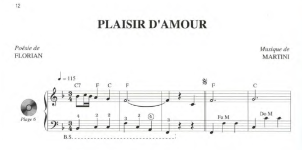I am trying to learn a couple of French pieces. Both are from ‘Accordéon Facile’ Vol 3 published by Paul Beuscher, ‘Plaisir d’Amour’, and ‘Le Petit Bal de la Marine.’ Each has a musical marking below some of the bass clef bars. B.S. followed by short dashes, not underlines, but at the same level, terminated with a | like character, only divided into two vertical dashes. I’ve tried to discover what this means without success. Anyone care to enlighten me?

